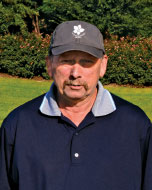Flower Power: How one course changed its fate
There’s something special about a municipal golf course — that beat-up old track where people often learn to love the game. Golf on a muni is usually a love-hate relationship: you love it because you’ve memorized every blade of grass on the course. It’s inexpensive and you can meet the most interesting people in a pickup game. You hate it because a city owned course can take five hours to play since the tee sheet is overflowing with hackers. But you can’t help but return again and again.
Two years ago Stevens Park Golf Course in Dallas was your typical muni course. Not anymore, thanks to a major reconstruction project. It’s lush, green, healthy and the general manager guarantees to get players around the course in four hours and 15 minutes — even on Saturdays.
When asked to compare the course before and after the renovation, superintendent Frank Hutcheson can’t help but smile.
“The old course just had push up greens that were built in the 1920s and ’30s,” Hutcheson says. “It was a typical municipal golf club, but now it can compete with all the private clubs in the area.”
Hutcheson, who joined the Stevens Park staff seven years ago, said the course in 2010 and the one today can hardly be compared. The old course was too short for modern-day golf at less than 5,900 yards. The grasses were outdated, and the greens had been around since the 1940s.
Stevens Park originally opened in 1924 and reached its prime in the 1980s, averaging 63,000 rounds annually. But as more courses saturated the area and the golf industry entered a recession, the course began to suffer. Conditions deteriorated. Play plummeted to nearly 35,000 rounds in 2010. It was time for a drastic makeover or risk losing one of the oldest golf courses in Dallas.
Rock solid obstacles
Although it took just 310 days to rebuild Stevens Park, the remodeling was difficult — and expensive. The project cost approximately $9.7 million, a jaw dropping number for most city-run golf courses. General Manager and Director of Golf, Jim Henderson raised the money through a combination of bonds and borrowed funds from the city, as well as a $3.5 million loan from Dallas Water Utilities. The city hired Arlington, Texas-based Colligan Golf Design and the well-known Wadsworth Golf Course Construction Company to work on the project.
The design team, led by John Colligan and his associate Trey Kemp, and the contractor faced their first obstacle the moment the bulldozer hit the dirt. The course was built on caliche rock and in many places it was barely three inches under the soil.
“The contractors literally peeled all the dirt off the rock, and then cut it to reconfigure and reshape the fairways, greens and tees,” Hutcheson says. “It was an intense process, but it was a lot of fun watching the old course being stripped away.”
Henderson says to stay within the budget they had to come up with their own soil supply by digging several pits near the creek on the golf course. Then the contractors used all the old trees, cart paths and other debris to fill up the pits again. To add extra soil, they sodded the entire course with Premier Tif fairways and Tifton 10 rough grass, except for the greens, which were seeded with Mini Verde.
The five roads that cross the 110-acre golf course presented another concrete barrier that left them with few options to add length to the course. Colligan was able to lengthen the course to 6,300 yards by rerouting 12 of the original holes. Additionally, he designed the fairways with mounding and collection areas to create more player-friendly landing zones.
“We didn’t want to build another championship golf course,” Henderson says. “Everyone is building golf courses that are 7,000-plus yards and so hard to play. If you’re going to lose golf balls all day, how is that going to be any fun?”
Spring time all year round
Creating a beautiful landscape was extremely important to Henderson, whose goal was to create a fun, player-friendly golf course that was also attractive. He knew they needed something unique to set the course apart from others in the area. It was the assistant director at the time, Barbara Kindig who came up with the idea of a garden-themed golf course.
“It’s totally opposite of the way [designers] are trying to build golf courses nowadays, which is building courses with zero landscape that use grasses and waste areas,” Henderson says.
He explains they wanted the course to blend seamlessly with the historic Kessler Park neighborhood by using the same plant material found around the houses to create an attractive public golf course that would compete with the beauty of high-end private clubs in the area.
It cost $700,000 to create two acres of landscaping around the course, which included 2,000 knockout rosebushes (which are water conservative), crape myrtles, magnolias and 900 new trees. Augusta National inspired the spring garden theme, Henderson says, so he chose flowers that would stay in bloom most of the year.
“The sheer beauty of the course is something that will set us apart for years to come,” the general manager says.
Hard work pays off
The result has proven to be worth the effort. Now the once dying municipal course in Dallas is bursting with color and life, as well as a full tee sheet almost every day. The course reopened in October 2011 and had 55,000 rounds of golf in its first year, averaging 200 to 220 golfers a day. Neither Henderson nor Hutcheson expect it to slow down.
“The upscale renovation put us in a whole different ballpark than what we used to be in,” Hutcheson says. “We have a completely different clientele playing here every day. People are coming from all over, even golfers who belong to local private clubs.”
Of course, not every city has millions of dollars to spend on a muni, but Henderson adopted a method that he said helps keep tee sheets filled daily that any course can use. When the course reopened, it moved to 10 minute tee times instead of the traditional eight. Henderson said it was controversial for the city because it means booking 20 percent fewer golfers, but he believes it works out for a better pace of play and happier customers.
“On the weekdays we’re staying booked because customers know we’re not going to cram as many people as we can onto the golf course, so they’re going to have fun playing,” Henderson says. “It’s about not being greedy, and it’s about providing a quality golfing experience.”
Henderson is no longer concerned if long-time customers would accept the new Stevens Park.
“My own dad and my grandpa used to bring me here to play golf, and many other people grew up playing this course back in the ’60s, ’70s and ’80s as well,” he says. “Now when those old players come back, they’re all so happy it turned out to be such a great product.”
Christina Thomas is a former collegiate golfer and a freelance golf journalist living in San Diego. This is her first story for Golfdom.












